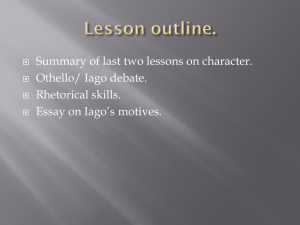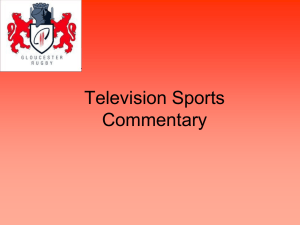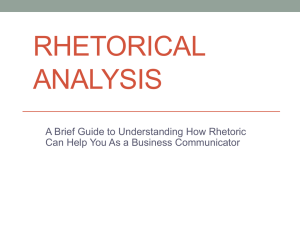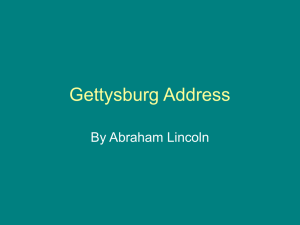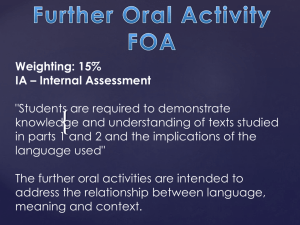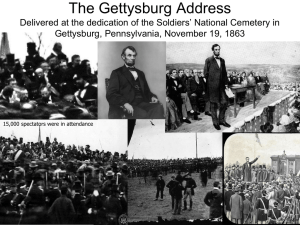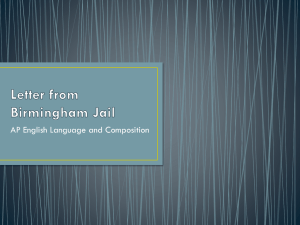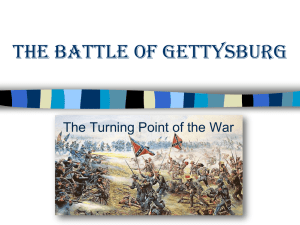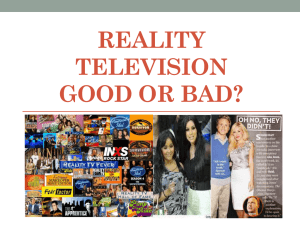Speeches PowerPoint Speech Unit_2
advertisement
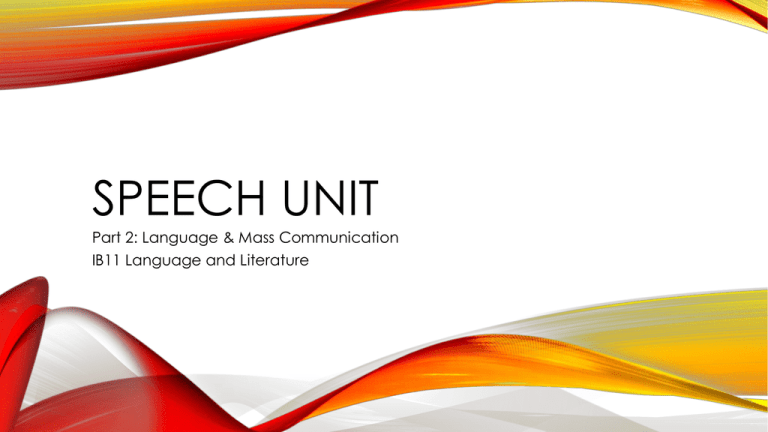
SPEECH UNIT Part 2: Language & Mass Communication IB11 Language and Literature RESEARCH • Using your SMART phones, research: • Nelson Mandela (imprisonment and President of South Africa) • Springbok Rugby Team • Apartheid (what was this in South Africa? Groups involved?) • Movie, Invictus MORGAN FREEMAN PORTRAYING NELSON MANDELA IN THE MOVIE INVICTUS • Context: The National Sports Council has just voted to change the colors, emblem and name of South Africa’s National Rugby Team, the Springboks. Upon hearing the news, Nelson Mandela (portrayed by Morgan Freeman) rushes to the meeting to persuade the Council to reconsider its vote. • Audience: • Purpose: • Effects: WHAT DOES THE TEXT SAY? • Text: Brothers, sisters, comrades, I am here because I believe you have made a decision with insufficient information and foresight. I am aware of your earlier vote. I am aware that it was unanimous. Commentary: Mandela lets the Council know from the outset that he disagrees with them. However, he is respectful of their authority and explicitly recognizes their vote and the fact that the vote was unanimous. WHAT DOES THE TEXT SAY? • Text: Nonetheless, I believe we should restore the Springboks. Restore their name, their emblem and their colors, immediately. • Commentary: He states his position clearly, forcefully and at the outset. There is no room for doubt. He still has his work cut out for him, but everyone knows where he stands. Coming clean with his audience at the outset will not likely win much support – but it should earn him some respect for having the courage to state his convictions openly. WHAT DOES THE TEXT SAY? • Text: Let me tell you why. On Robben Island, in Pollsmoor Prison, all of my jailers were Afrikaners. For 27 years, I studied them. I learned their language, read their books, their poetry. I had to know my enemy before I could prevail against him. • Commentary: Here begins the argument. He immediately seeks common ground with his audience. And that ground is obvious – the years of oppression that they all suffered under Apartheid. Of course, Mandela had it worse than most; but he doesn’t pity himself. Instead, he talks about the effort he went through to understand the “enemy” – a strong word – in order to prevail against him. WHAT DOES THE TEXT SAY? • Text: And we did prevail, did we not? All of us here … we prevailed. #1 Commentary: ?? WHAT DOES THE TEXT SAY? • Commentary: Again, seeking common ground. And also letting the audience know, subtly, that they have already won. There is no need to continue to fight. WHAT DOES THE TEXT SAY? • Text: Our enemy is no longer the Afrikaner. They are our fellow South Africans, our partners in democracy. • #2 Commentary: ?? WHAT DOES THE TEXT SAY? • Commentary: This comes as a shock to many in the audience, but Mandela has to get his point out: times have changed; we need to work together to build the country. It is here that he starts to appeal to his audience to think about a higher ideal. • Text: And they treasure Springbok rugby. If we take that away, we lose them. We prove that we are what they feared we would be. • #3 Commentary: ?? WHAT DOES THE TEXT SAY? • Commentary: Emphasizing that rugby is something more than a sport for the Afrikaners; it is something that runs deep within them. Note the gesture with his fist. And note also the caution at the end that the Council risks becoming, in a sense, as oppressive as the Afrikaners had been in the past. This is a powerful rhetorical tool – showing the audience that their position is similar to something against which they are adamantly opposed. WHAT DOES THE TEXT SAY? • Text: We have to be better than that. We have to surprise them with compassion, with restraint, and generosity • #4 Commentary: ?? WHAT DOES THE TEXT SAY? • Commentary: Another call to a higher ideal. WHAT DOES THE TEXT SAY? • Text: I know. All of the things they denied us. • #5 Commentary: ?? WHAT DOES THE TEXT SAY? • Commentary: Again recognizing the suffering of the audience in the past. WHAT DOES THE TEXT SAY? • Text: But this is no time to celebrate petty revenge. This is the time to build our nation using every single brick available to us – even if that brick comes wrapped in green and gold. • Commentary: ?? WHAT DOES THE TEXT SAY? • Commentary: But immediately appealing once more to the higher ideal and the importance of using every available resource to build the country. WHAT DOES THE TEXT SAY? • Text: You elected me your leader. Let me lead you now. Who is with me on this? Who is with me? • #6 Commentary: ?? WHAT DOES THE TEXT SAY? • Commentary: Asserting his authority and ending with a call to action. ANY GIVEN SUNDAY • Get into groups • Watch movie trailer • Watch Al Pacino’s speech • Fill in Audience, Purpose, Effects (of speech) • For group assignments: What do you notice in the speech? What’s Pacino saying? What’s the effect of different elements that you notice? High light these elements and write down notes. --Write down notes ANY GIVEN SUNDAY • Get into combined groups and compare notes • Present notes to class. Class take notes. “WHAT’S IN YOUR BACK PACK?” • Get into groups • Watch movie trailer • Watch George Clooney’s speech • Fill in Audience, Purpose, Effects (of speech) • For group assignments: What do you notice in the speech? What’s Clooney saying? What’s the effect of different elements that you notice? High light these elements and write down notes. --Write down notes WHAT’S IN YOUR BACK PACK? • Get into combined groups and compare notes • Present notes to class. Class take notes. COMP. BOOK #6 • What makes a good speech? • What does a speaker need to do? • What have you noticed works well in Morgan Freeman’s speech as Nelson Mandela and Al Pacino/George Clooney’s speeches? ANALYZING SPEECHES WHAT IS THE RELATIONSHIP BETWEEN SPEECHES AND RHETORIC? • Greek philosopher Aristotle defined rhetoric as “the faculty of observing in any given case the available means of persuasion.” Basically, it is the study and the art of using language effectively to persuade an audience. Speakers use rhetoric to persuade or compel the audiences of their speeches. CONTEXT & PURPOSE • Rhetoric is always situational – it has a context – the occasion or the time and place it was written or spoken – and a purpose or goal that the speaker or writer wants to achieve. CONTEXT • When considering context – consider current events or cultural bias that the speaker must take into account. PURPOSE • When considering purpose – ask if the speaker is trying to win agreement, persuade us to take action, evoke sympathy, make someone laugh, inform, provoke, celebrate, repudiate, put forth a proposal, secure support, or bring about a favorable decision ARISTOTLE’S RHETORICAL TRIANGLE • Before looking at the construction of arguments, it is first necessary to look at their shape and form. To do this, we must recognize that arguments occur within a social context--they are the process/product of people interacting, and relating. Over the years, several scholars have mapped out these relations, much as you would a family tree. Aristotle was the first to notice the similarities of arguments and stories. For Aristotle, the act of storytelling consisted of three elements: a story, a storyteller, and an audience. ARISTOTLE’S RHETORICAL TRIANGLE Storyteller------------------------>Story----------------------------->Audience Similarly, arguments also required these three elements: Speaker/Writer--------------------->Message------------------->Audience ARISTOTLE’S RHETORICAL TRIANGLE • Aristotle defined these three elements as ETHOS, LOGOS, and PATHOS. Since then, different scholars have conceived of different models of rhetoric, but the model we are concerned with comes from Robert Scholes. Realizing the three elements, Scholes examined the relationship between the speaker/message, speaker/audience, and message/audience. These three relations make up the three sides of the rhetorical triangle. You may use this triangle to map out the overall effectiveness of an argument. ARISTOTLE’S RHETORICAL TRIANGLE Note how the equilateral triangle below would refelct an argument with a careful balance of ethos, logos, and pathos. HOW DO SPEAKERS USE RHETORIC TO PERSUADE AUDIENCES? • According to Aristotle, speakers use the three corners of the rhetorical triangle to persuade audiences. ETHOS • Ethos – represents the author's ability to reveal his or her credibility through the tone established, his/her reputation, or the type or thoroughness of the information being presented. (speaker) ETHOS PATHOS • Pathos - represents the author's ability to appeal to the audience through the use of figurative language, allusions, personal anecdotes, etc. to engage their emotions. (audience) http://www.storyboardthat.com/userboards/kated/pathos-in-action PATHOS LOGOS • Logos - represents the author's ability to reveal logic and reason through their offering of a clear claim (or main idea), specific details, examples, facts, statistical data, or expert testimony and support. (subject) http://www.storyboardthat.com/userboards/kated/logos-in-action LOGOS YOUR TURN • You are to write appeals based on ethos, pathos and logos. • Your appeals must all be based on the same product or idea. • Be creative. • Have fun. • We will share these with the class. WORKS CITED • Docimo, Katherine. "Ethos, Pathos, Logos." Storyboardthat.com. N.p., 13 June 13. Web. 19 Sept. 14. DICTION • How does diction play a role in rhetoric? DICTION • The words speakers use shape an audience’s impression. Understanding how diction works is paramount to understanding rhetoric. QUESTIONS TO CONSIDER WHEN ANALYZING DICTION: • Which of the important words in the passage (verbs, nouns, adjectives, and adverbs) are general and abstract? Which are specific and concrete? What is the effect of abstract words? What is the effect of concrete words? • Are the important words used formal, informal, colloquial, or slang? What is the effect of using formal diction? What is the effect of using slang? • Are some words used non-literal or figurative (figures of speech such as a metaphor or simile)? What is the effect of using a metaphor or simile? SYNTAX • Another important aspect to consider is syntax, or the organization of words into sentences QUESTIONS TO CONSIDER WHEN ANALYZING SYNTAX: • What is the order of the parts of the sentence? Is it the usual (subject-verbobject), or is it inverted? What is the effect of an inverted sentence? • Which part of speech is more prominent – nouns or verbs? What is the effect of a noun-heavy sentence? • What are the sentences like? Are they periodic (moving toward something important at the end) or cumulative (adding details and support as important idea in the beginning of the sentence)? What is the effect of using a periodic sentence? • Are the sentences short, medium length, or long? What is the effect of the length of sentences? “THE GETTYSBURG ADDRESS” • Take out your phones or computers. • Research The Battle of Gettysburg RHETORICAL DEVICES • The speech is full of rhetorical devices. • Each of these devices was chosen by Lincoln for a specific effect. YOUR TASK • Rewrite the speech removing ALL rhetorical features from it. • You are to create a speech with the same meaning, but without any flourish. • You will do this with your tablemate. • While you do this, I will check off your speech terms set. ENUMERATIO • Figure of amplification in which a subject is divided into constituent parts or details, and may include a listing of causes, effects, problems, solutions, conditions, and consequences; the listing or detailing of the parts of something. WARM UP: ENUMERTIO • "Much will be said about my father the man, the storyteller, the lover of costume parties, a practical joker, the accomplished painter. He was a lover of everything French: cheese, wine, and women. He was a mountain climber, navigator, skipper, tactician, airplane pilot, rodeo rider, ski jumper, dog lover, and all-around adventurer. Our family vacations left us all injured and exhausted. He was a dinner table debater and devil's advocate. He was an Irishman, and a proud member of the Democratic Party." -- Ted Kennedy, Jr., Eulogy for Ted Kennedy, Sr. http://www.americanrhetoric.com/figures/enumeratio.htm WARM-UP: ENUMERATIO Kramer: "Who's gonna turn down a Junior Mint? It's chocolate; it's peppermint; it's delicious." Seinfeld: "That's true." Kramer: "It's very refreshing!“ -- from the TV sitcom Seinfeld http://www.americanrhetoric.com/mp3clips/figures/seinfeldenumeratio.mp3 COMP. BOOK #8: SPEECH TERM WARM-UP: ENUMERATIO • Write a series of sentences which employ enumeratio. BACKGROUND RESEARCH “THE GETTYSBURG ADDRESS” PRESENTATION • Group Work • #1: Abraham Lincoln • #2: “The Gettysburg Address” • #3: The Battle of Gettysburg Directions: 1) Label each piece of butcher paper with title of subject (e.g. Abraham Lincoln) 2) List at least 6 facts about your assigned topic 3) Present your poster C.A.P.E. • Context: • Audience: • Purpose: • Effect(s): LISTEN TO “THE GETTYSBURG ADDRESS” • Colin Powell https://www.youtube.com/watch?v=Mn4pUQmimOc • Ken Burns https://www.youtube.com/watch?v=ndmcgAsA1aI DISCUSS “THE GETTYSBURG ADDRESS” • What do you notice? • What is Abraham Lincoln saying? PARALLELISM Parallelism: Figure of balance identified by a similarity in the syntactical structure of a set of words in successive phrases, clauses, sentences; successive words, phrases, clauses with the same or very similar grammatical structure. This figure often occurs in a public address with others such as antithesis, anaphora, asyndeton. WARM-UP: PARALLELISM • "Let every nation know, whether it wishes us well or ill, that we shall pay any price, bear any burden, meet any hardship, support any friend, oppose any foe to assure the survival and the success of liberty.“ -- John F. Kennedy, Inaugural Address http://www.americanrhetoric.com/mp3clips/figures/jf kparallelism.mp3 WARM-UP: PARALLELISM • "I've tried to offer leadership to the Democratic Party and the Nation. If, in my high moments, I have done some good, offered some service,shed some light, healed some wounds, rekindled some hope, or stirred someone from apathy and indifference, or in any way along the way helped somebody, then this campaign has not been in vain." -- Jesse Jackson, 1984 Democratic National Convention Address http://www.americanrhetoric.com/mp3clips/figures/jessejacksonparallelism.mp3 WARM-UP: PARALLELISM • "We have seen the state of our Union in the endurance of rescuers, working past exhaustion. We've seen the unfurling of flags, the lighting of candles, the giving of blood, the saying of prayers -- in English, Hebrew, and Arabic." George W. Bush, 9-20-01 Address to the Nation on Terrorism http://www.americanrhetoric.com/mp3clips/figures/georgewbushparallelism. mp3 COMP. BOOK #8: SPEECH TERM WARM-UP: PARALLELISM • Write a series of sentences which employ parallelism. ANAPHORA • Anaphora (an-NAF-ruh): Figure of repetition that occurs when the first word or set of words in one sentence, clause, or phrase is/are repeated at or very near the beginning of successive sentences, clauses, or phrases; repetition of the initial word(s) over successive phrases or clauses. WARM-UP:ANAPHORA • "To raise a happy, healthy, and hopeful child, it takes a family; it takesteachers; it takes clergy; it takes business people; it takes community leaders; it takes those who protect our health and safety. It takes all of us."-- Hillary Clinton, 1996 Democratic National Convention Address Note: Can you spot the alliteration? http://www.americanrhetoric.com/mp3clips/figures/ hillaryclintonanaphora.mp3 WARM-UP: ANAPHORA • "That my heart has been troubled, that I have not sought this nomination, that I could not seek it in good conscience, that I would not seek it in honest self-appraisal, is not to say that I value it the less. Rather, it is that I revere the office of the Presidency of the United States."-- Adlai Stevenson, 1952 DNC Presidential Nomination Acceptance Address http://www.americanrhetoric.com/mp3clips/figures/adlaistevensonanaphora. mp3 WARM-UP: ANAPHORA • "What we need in the United States is not division. What we need in the United States is not hatred. What we need in the United States is not violence and lawlessness; but is love and wisdom and compassion toward one another, and a feeling of justice toward those who still suffer within our country whether they be white or whether they be black." -- Robert F. Kennedy, Announcing the death of Martin Luther King http://www.americanrhetoric.com/mp3clips/figures/rfkanaphora.mp3 “SECOND INAUGURAL” • Today we are going to start looking at Lincoln’s “Second Inaugural” speech. • What is an inaugural speech? INTRODUCTION • Write an introduction as if you were writing an analysis essay for “The Gettysburg Address” • Details • Begin with a “hook” • Consider the background research you’ve done --The Battle of Gettysburg (1/3) --”The Gettysburg Address” (2/3) • Include a claim as the last sentence • Must be 5-8 sentences in length INTRO. HOOK---FIVE STRATEGIES • Make a controversial statement • Ask a question • Define your subject • Compare your subject to something compelling • Quote someone else BACKGROUND RESEARCH “SECOND INAUGURAL” Directions: GOAL: Establish context and purpose of this speech 1) Research Lincoln’s speech 2) Write down at least 6 facts on the back of the speech that you found. 3) Walk around room and add your research to the hanging posters. Your contribution must be original ANALYZING A SPEECH •What should do after you have established the context for the speech? ANALYZING A SPEECH • Read for comprehension • Circle unknown or interesting words • Patterns DISTINCTIO • Distinctio: Figure of explication (full explanation) in which an introductory reference to a word's meaning is made (e.g., "by x I mean", "which is to say that", "that is") followed by a further elaboration of that word's meaning; explicit definition of or elaboration upon the meaning or meanings of a particular word or set of words. WHICH RHETORICAL DEVICE IS IT? • "Let me walk you through the five procedural errors that occurred in conjunction with that mission [the flying of 12 cruise missiles back to Barksdale AFB, Louisiana] that facilitated this serious and unprecedented incident. As you see here -- if we'll bring up slide 1, please -- on the morning of August 29th, a team of Minot airmen was dispatched to the base Weapons Storage Area to pick up and transport two pylons to a Barksdale B52 aircraft. For those of you unfamiliar with the term "pylon," for our purposes today, a pylon is a self-contained package of six cruise missiles that can be quickly mounted to the wing of a B-52."-- U.S. Department of Defense briefing on B-52 munitions and the "Bent Spear" incident, delivered 20 October 2007 by Major General Richard Y. Newton III, USAF http://www.americanrhetoric.com/figures/distinctio.htm WHICH RHETORICAL DEVICE IS IT? • "I've been in football all my life, really, and I want to say this -- that it's a great game, and it's a Spartan type of game. I mean by that it takes Spartan qualities in order to be a part of it, to play it. And I speak of the Spartan qualities of sacrifice and self-denial rather than that other Spartan quality of leaving the weak to die." -- Vince Lombardi http://www.americanrhetoric.com/mp3clips/figures/vincelombardidistinctio.m p3 DISTINCTIO • "It was the best of times, it was the -- I say -- worst of times -- andby worse I'm talkin' as bad -- I say -- as bad as my aunt Jenny's corn puddin'. That stuff will sink you like a stone."-- delivered by Foghorn Leghorn for GEICO http://www.americanrhetoric.com/figures/distinctio.htm COMP. BOOK # DR. MARTIN LUTHER KING, JR. “I Have a Dream” BACKGROUND RESEARCH “I HAVE A DREAM” Directions: GOAL: Establish context and purpose of this speech • Research King’s speech • Write down at least 10 facts for the following topics: 1. Dr. Martin Luther King, Jr. 2. Civil Rights Movement (1960s) 3. “I Have a Dream” Speech SHARE RESEARCH • Get together in larger group according to topic • Discuss research • Compile research and create word doc. with top 10 points to be shared with the class • Email doc. to Mrs. Milstead: milsteada@edmonds.wednet.edu TIME DUE: 1:15 • Groups present their research to the class. • Audience to take notes ANALYZING A SPEECH •What should do after you have established the context for the speech? ANALYZING A SPEECH • Read for comprehension • Circle unknown or interesting words • Patterns “I HAVE A DREAM” • https://www.youtube.com/watch?v=smEqnnklfYs ANALYZING A SPEECH •The Big 5 of textual analysis •Tone/ Mood Sheet ANTITHESIS • Antithesis (an-TIH-theh-sis): Figure of balance in which two contrasting ideas are intentionally juxtaposed, usually through parallel structure; a contrasting of opposing ideas in adjacent phrases, clauses, or sentences. Ex: "He is no fool who gives what he cannot keep to gain that which he cannot lose" -- Jim Elliot • Ex: Lloyd Braun: "Serenity now; insanity later." -from Seinfeld episode "The Serenity Now" WHICH RHETORICAL DEVICE IS IT? • "I have a dream that my four little children will one day live in a nation where they will not be judged by the color of their skin but by the content of their character. I have a dream today!"-- Martin Luther King, Jr., I Have a Dream http://www.americanrhetoric.com/mp3clips/figures /martinlutherkingantithesis.mp3 WHICH RHETORICAL DEVICE IS IT? • "The world will little note, nor long remember, what we say here, but it can never forget what they did here."-Abraham Lincoln, Gettysburg Address (delivered by Jeff Daniels) http://www.americanrhetoric.com/mp3clips/figures/abrahamlincolnantithesis. mp3 ANTITHESIS • "...although the surface appears to be...very, very fine-grained as you get close to it. It's almost like a powder...Okay, I'm going to step off the LEM now. That's one small step for [a] man; one giant leap for mankind."-- Neil Armstrong, Apollo 11 Moon Landing Speech http://www.americanrhetoric.com/mp3clips/figures/ neilarmstrongantithesis.mp3 ANNOTATE THE SPEECH • Individually annotate assigned section • With a partner: • Share annotations/ continue to annotate assigned section of the speech for rhetorical terms • Prepare a PowerPoint presentation • Read passage • Explain what passage is about • Present annotations & their effects • Submit to turnitin.com • PowerPoint should be clear and easy to understand and see MINI SPEECH ASSIGNMENT • Speech opening, position, and point • 500 words MLA format MINI SPEECH ASSIGNMENT— BRAINSTORM TOPIC Individually…. Choose topic 1. State position 2. What points are you going to cover * Complete this work beneath the rubric on the back of the assignment sheet. Table partners… Share what you brainstormed MINI SPEECH ASSIGNMENT— OUTLINE I. Outline due: Friday, Oct. 10th A. typed B. bring two copies to class **Reference Milstead sample outline from Mrs.
